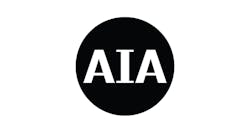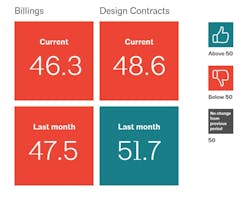Architecture Billings Index Contracts Again
PRESS RELEASE
WASHINGTON – Dec. 16, 2020 – Architecture firm billing activity is contracting once again after two months of a slowing decline, according to a new report from the American Institute of Architects (AIA).
The pace of decline during November accelerated from October, posting an Architecture Billings Index (ABI) score of 46.3 from 47.5 (any score below 50 indicates a decline in firm billings). The pace of inquiries into new projects slowed, but remained positive with a score of 52.0, however the value of new design contracts dipped back into negative territory with a score 48.6.
“In previous design cycles, we typically haven’t seen a straight line back to growth after a downturn hits,” said AIA Chief Economist, Kermit Baker, Hon. AIA, PhD. “The path to recovery is shaping up to be bumpier than we hoped for. While there are pockets of optimism in design services demand, the overall construction landscape remains depressed.”
Key ABI highlights for November include:
- Regional averages: Midwest (50.1); West (48.3); South (46.7); Northeast (38.7)
- Sector index breakdown: multi-family residential (52.2); mixed practice (49.5); commercial/industrial (47.5); institutional (41.9)
- Project inquiries index: 52.0
- Design contracts index: 48.6
The regional and sector categories are calculated as a three-month moving average, whereas the national index, design contracts and inquiries are monthly numbers.
Visit AIA’s website for more ABI information.
The recent increase in COVID-19 cases over the last several weeks seems to have put a damper on the nascent recovery, and also appears to be reflected in a decline in the value of new design contracts in November, following their first increase since February last month. In addition, while inquiries into new work continued to rise, the pace of that growth slowed substantially from the previous two months. Together, these signs indicate that client interest in new projects has started to wane after more encouraging signs last month.
Business conditions also remained soft across much of the country in November, with billings weakening most noticeably at firms located in the Northeast, which were also hardest hit earlier in the pandemic. However, architecture firms in the Midwest saw their billings rise slightly for the first time since January. In addition, this month firms with a multifamily residential specialization saw modest growth for the fourth consecutive month, as that sector remains the one bright spot amid the pandemic-induced downturn.
But billings continued to decline at both firms with commercial/industrial and institutional specializations, with firms with a commercial/industrial specialization seeing a less dramatic decline, likely due to increased demand for distribution, logistics, data centers, and other industrial facilities recently.
Growth in a few key sectors
In the broader US economy, nonfarm payroll growth slowed substantially in November, with just 245,000 new jobs added, versus 610,000 in October. Despite strong gains throughout much of the summer and early fall, nonfarm payroll employment remains nearly 10 million jobs below its February pre-pandemic peak. Construction employment increased by 27,000 in November, and is now 279,000 below its February peak, while architectural services employment added 900 new jobs in October (the most recent data available), bringing it to within about 10,000 positions of its pre-pandemic peak of 200,000, after losing nearly 17,000 jobs earlier this year.
In addition, according to the latest edition of the Federal Reserve’s Beige Book Report (released on December 2), most regions of the country experienced a modest to moderate expansion from late October into November, although some areas started to see growth slowing by mid-November as COVID-19 cases rose again. The report found that earlier optimism has waned in recent weeks, largely due to the recent virus surge as well as the forthcoming expiration of unemployment benefits and the moratorium on evictions and foreclosures.
However, growth has continued to increase in certain sectors, namely homebuilding, existing home sales, manufacturing, and distribution and logistics. Regionally, the New York, Richmond, Atlanta, Kansas City, Dallas, and San Francisco Districts reported particularly strong conditions in their residential real estate markets, while softening commercial real estate markets were reported in the New York, Dallas, and San Francisco Districts, and the Richmond District reported that commercial real estate leasing was increasing in that region.
Varied firm outlooks for 2021
This month, we asked responding architecture firms to share their expectations for 2021, and what their biggest business-related concerns for the coming year are. Overall, firms are modestly optimistic – while just 7% expect that 2021 will be a great year for their firm, 39% expect that it will be a good year, and 25% predict a so-so year. However, 25% anticipate a challenging year, while 4% are worried that 2021 will be a potentially disastrous year for their firm.
Notably, firms located in the Northeast, where conditions were weak even prior to the pandemic, expressed the most concern for 2021, while firms with a multifamily residential specialization were most likely to predict a good to great year ahead.
As far as the biggest business-related concerns for firms in 2021, increasing firm profitability remained the top concern again this year, cited as one of their top three concerns by 29% of responding firms. The top concerns cited by firms were split fairly evenly between general concerns about running their business and concerns related to the impact of the COVID-19 pandemic. Some of the other top concerns from last year, primarily related to issues around hiring and retaining staff, dropped off the list this year, amid the economic downturn and staff layoffs and furloughs.
Other top concerns related to project and firm management were about identifying new clients and new markets, enhancing firm business planning, and marketing (cited by 24% of firms as one of their top three concerns for 2021); negotiating appropriate projects fees (20% of firms); dealing with firm ownership transition issues (16% of firms); dealing with competition from other architecture firms/design professionals (13% of firms); and managing the rising costs of running a firm (12% of firms). Identifying new clients/new markets was of particular concern to firms with commercial/industrial and institutional specializations, since those have been hardest hit by the impact of the pandemic.
The top concerns cited that were related directly to the impact of the pandemic were issues generally related to staff management while working remotely, including maintaining levels of staff productivity while working remotely (17% of firms), retaining their key staff until more business returns (12% of firms), and ensuring collaboration and communication among management and staff while working remotely (11% of firms). Just over one in 10 firms (11%) listed rebuilding their client base, or finding a new client base post-pandemic, as one of their top concerns, as firms indicated that they’ve had to shift to focus on new project types, or adjust their mix of projects, to weather the current downturn.
About AIA
Founded in 1857, AIA consistently works to create more valuable, healthy, secure, and sustainable buildings, neighborhoods, and communities. Through more than 200 international, state and local chapters, AIA advocates for public policies that promote economic vitality and public wellbeing.
AIA provides members with tools and resources to assist them in their careers and business as well as engaging civic and government leaders and the public to find solutions to pressing issues facing our communities, institutions, nation, and world. Members adhere to a code of ethics and conduct to ensure the highest professional standards.
Contact
Matt Tinder, 202 626 7462

